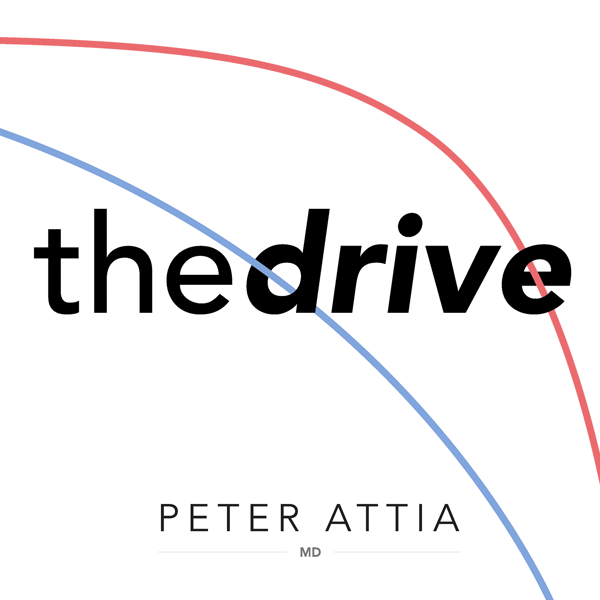#201 - Deep dive back into Zone 2 | Iñigo San-Millán, Ph.D. (Pt. 2)
The Peter Attia Drive
Peter Attia, MD
4.7 • 7.3K Ratings
🗓️ 28 March 2022
⏱️ 166 minutes
🧾️ Download transcript
Summary
View the Show Notes Page for This Episode
Become a Member to Receive Exclusive Content
Episode Description:
Iñigo San-Millán is an internationally renowned applied physiologist and a previous guest on The Drive. His research and clinical work focuses on exercise-related metabolism, metabolic health, diabetes, cancer metabolism, nutrition, sports performance, and critical care. In this episode, Iñigo describes how his work with Tour de France winner Tadej Pogačar has provided insights into the amazing potential of elite athletes from a performance and metabolic perspective. He speaks specifically about lactate levels, fat oxidation, how carbohydrates in food can affect our lactate and how equal lactate outputs between an athlete and a metabolically unhealthy individual can mean different things. Next, he discusses how Zone 2 training boosts mitochondrial function and impacts longevity. He explains the different metrics for assessing one’s Zone 2 threshold and describes the optimal dose, frequency, duration, and type of exercise for Zone 2. Additionally, he offers his thoughts on how to incorporate high intensity training (Zone 5) to optimize health, as well as the potential of metformin and NAD to boost mitochondrial health. Finally, he discusses insights he’s gathered from studying the mitochondria of long COVID patients in the ICU.
We discuss:
- The amazing potential of cyclist Tadej Pogačar [3:00];
- Metrics for assessing athletic performance in cyclists and how that impacts race strategy [8:30];
- The impact of performance-enhancing drugs and the potential for transparency into athletes’ data during competition [17:00];
- Tadej Pogačar’s race strategy and mindset at the Tour de France [24:00];
- Defining Zone 2, fat oxidation, and how they are measured [26:45];
- Using fat and carbohydrate utilization to calculate mitochondrial function and metabolic flexibility [35:45];
- Lactate levels and fat oxidation as it relates to Zone 2 exercise [40:00];
- How moderately active individuals should train to improve metabolic function and maximize mitochondrial performance [51:45];
- Bioenergetics of the cell and what is different in elite athletes [57:30];
- How the level of carbohydrate in the diet affects fuel utilization and power output during exercise [1:08:30];
- Glutamine as a source for making glycogen—insights from studying the altered metabolism of ICU patients [1:15:00];
- How exercise mobilizes glucose transporters—an important factor in diabetic patients [1:21:00];
- Metrics for finding Zone 2 threshold—lactate, heart rate, and more [1:25:00];
- Optimal Zone 2 training: dose, frequency, duration, and type of exercise [1:41:15];
- How to incorporate high intensity training (Zone 5) to increase VO2 max and optimize fitness [1:51:15];
- Compounding benefits of Zone 2 exercise and how we can improve metabolic health into old age [2:01:45];
- The effects of metformin, NAD, and supplements on mitochondrial function [2:05:15];
- The role of lactate and exercise in cancer [2:13:30];
- How assessing metabolic parameters in long COVID patients provides insights into this disease [2:19:00];
- The advantages of using cellular surrogates of metabolism instead of VO2 max for prescribing exercise [2:25:45];
- Metabolomics reveals how cellular metabolism is altered in sedentary individuals [2:33:45];
- Cellular changes in the metabolism of people with diabetes and metabolic syndrome [2:39:15]; and
- More.
Sign Up to Receive Peter’s Weekly Newsletter
Connect With Peter on Twitter, Instagram, Facebook and YouTube
Transcript
Click on a timestamp to play from that location
| 0:00.0 | Hey everyone, welcome to the Drive Podcast. |
| 0:13.0 | I'm your host, Peter Atia. |
| 0:14.8 | This podcast, my website, and my weekly newsletter, all focus on the goal of translating |
| 0:18.7 | the science of longevity into something accessible for everyone. |
| 0:22.4 | Our goal is to provide the best content in health and wellness, full stop, and we've assembled |
| 0:27.0 | a great team of analysts to make this happen. |
| 0:29.4 | If you enjoy this podcast, we've created a membership program that brings you far more |
| 0:33.2 | in depth content if you want to take your knowledge of this space to the next level. |
| 0:37.3 | At the end of this episode, I'll explain what those benefits are, or if you want to learn |
| 0:41.0 | more now, head over to peteratiamd.com forward slash subscribe. |
| 0:46.3 | Now without further delay, here's today's episode. |
| 0:51.0 | My guess this week is Inigo San Malan. |
| 0:53.9 | Inigo was a previous guest on the drive back in December of 2019. |
| 0:58.7 | That episode was incredibly popular. |
| 1:00.2 | We not only rebroadcasted it, but we reached out to many of you for follow-up questions |
| 1:04.6 | and that of course preceded this episode. |
| 1:06.6 | We talk about a lot of stuff here. |
| 1:07.9 | We begin the conversation around Inigo's work with Tour de France winner, two-time winner |
| 1:11.9 | now, Teddy Bogachat, looking at the type of training that he does and getting a sense of |
| 1:17.1 | really what the best of the best in the world are capable of. |
| 1:19.8 | Then of course, now we can use that to sort of benchmark ourselves. |
| 1:22.7 | We speak specifically about lactate, levels, fat oxidation, the relationship between watts |
... |
Please login to see the full transcript.
Disclaimer: The podcast and artwork embedded on this page are from Peter Attia, MD, and are the property of its owner and not affiliated with or endorsed by Tapesearch.
Generated transcripts are the property of Peter Attia, MD and are distributed freely under the Fair Use doctrine. Transcripts generated by Tapesearch are not guaranteed to be accurate.
Copyright © Tapesearch 2025.

